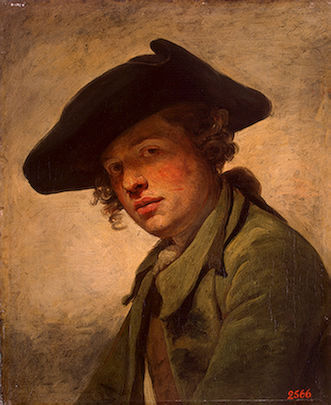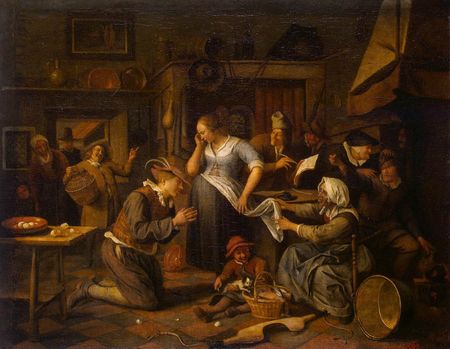The Romanovs, Tsars and Art Collectors @ the Pinacothèque de Paris
Rembrandt (Harmensz Van Rij, dit), David et Jonathan, 1642. Huile sur bois (parquetage), 73 x 61,5 cm. INV. N° ГЭ 713. Provenance : 1882, Imperial Picture Gallery in the Monplaisir Palace, Peterhof. Musée de l'Ermitage, Saint-Pétersbourg. Photographe © Musée de l'Ermitage. Photo de Pavel Demidov.
PARIS.- For the opening of its new rooms, the Pinacothèque de Paris has organised an exceptional exhibition around a major theme: the birth of a Museum. Through May 29 2011, the Pinacothèque de Paris displays the treasures of the Romanovs, a unique ensemble consisting of a hundred works from the Hermitage Museum in Saint-Petersburg.
Assembled since the end of the 17th century, the Russian imperial collections have quickly become part of the largest European collections. As early as 1785, Count Ernst von Münnich declares: “The foreigners and visitors eager to know the country who have been given the opportunity to see the vast and rich galleries of paintings all agree on their magnificence.
The chronological organisation starts with the presentation of the works gathered by Peter I (1672-1725). An inquiring mind and a well informed collector, Peter I sends his agents all over Europe with the task of bringing back paintings and sculptures to Saint-Petersburg.
Particularly interested in Dutch paintings, Peter I buys on the art market in Amsterdam biblical paintings like the splendid David and Jonathan by Rembrandt as well as seascapes and genre paintings of outstanding quality like The Marriage Contract, by Jan Steen. The Italian school is represented by a superb Entombment by Garofalo, then attributed to Raphaël, a gift from Cardinal Pietro Ottoboni.
Jan Steen (b. 1626, Leiden, d. 1679, Leiden), The Marriage Contract, c. 1668. Oil on canvas, 65 x 83 cm. The Hermitage, St. Petersburg
Benvenuto Tisi da Garofalo, The Entombment. Oil on canvas. 53x75.5 cm, Italy. 1520s. Provenance: Collection of Cardinal Ottoboni, Rome. The Hermitage, St. Petersburg © 2006 State Hermitage Museum
An enlightened sovereign immersed in the Age of Enlightenment, Catherine the Great (1729-1796) enlarges the collections. Between 1764 and 1775, she builds the first site dedicated to their exhibition: the Small Hermitage, close to the Winter Palace. Very soon, the building is too small for the increasing number of works and the Large or Old Hermitage is built a few years later, between 1771 and 1787.
Catherine the Great gives the collection an encyclopaedic dimension, which enables her to assert her political prestige. Paris is the place where she purchases her main masterpieces, through prestigious correspondents such as Diderot or Baron Grimm. In Jean de Julienne’s collection, she selects, among others, Physician Visiting a Sick Girl, by Gabriel Metsu. But her greatest success is probably the acquisition of the whole collection of the banker and patron Gabriel Metsu: the Portrait of an Actor by Domenico Fetti, the sketch for The entry of Marie de Médicis in Lyon by Rubens, the Lovers in a Hunting Party and Venus, Faun and Putti by Poussin, The Incredulity of St. Thomas, by Van Dyck or the Portrait of a Young Man in a Hat by Greuze; all these works become part of the imperial collections. Finally, it is also in Paris that she purchases Count Baudouin’s Cabinet in which Van Dyke’s paintings compete with those by Rembrandt, Rubens or Ruysdael. Each time, a wave of indignation shakes the Parisians, reluctant to see so many great works leave the French territory to be exported towards Russia. Catherine’s prestige is enhanced by her actions. When she dies, the gallery counts more than 4000 paintings.
Gabriel Metsu, Visit of the Physician, 1660-67. Oil on canvas, 61 x 48 cm. Provenance: Collection of J. de Jullienne, Paris. 1767 ©2003 State Hermitage Museum
Domenico Fetti, Portrait of an Actor (Tristano Martinelli or Francesco Andreini ?) , 1623. Oil on canvas, 105,5 x 81 cm. Provenance: Collection of J. de Jullienne, Paris. 1767. The Hermitage, St. Petersburg ©2003 State Hermitage Museum
Pieter Paul. Rubens, The entry of Marie de Médicis in Lyon . Oil on canvas, grisaille painting. 33.5x24.2 cm, Flanders. 1622. Provenance: Collection of baron L.A. Crozat de Tierra, Paris. 1772 . The Hermitage, St. Petersburg ©2003 State Hermitage Museum
Nicolas Poussin, Venus, Faun and Putti. Oil on canvas. 72x56 cm, France. Early 1630s. The Hermitage, St. Petersburg ©2003 State Hermitage Museum
Anthony Van Dyck, The Incredulity of St. Thomas ( Appearance of Christ to his Disciples). Oil on canvas. 147x110.3 cm,
Flanders. 1625/1626. The Hermitage, St. Petersburg ©2003 State Hermitage Museum.
Alexander I (1777-1825), Catherine II’s worthy grandson, also leaves his mark in the imperial collections, providing the Hermitage, among others, with a superb collection of Spanish masters. During the Napoleonic wars, the Russians, feeling assaulted, identify with the heroic Spaniards who resist the French troops. The acquisition of the Coesvelt Collection enables the great names of the Spanish Golden century to enter the imperial gallery. Among them, the extraordinary Portrait of Count-Duke of Olivares by Velasquez and the mystical Annunciation by Murillo. Among the 38 paintings purchased by Alexander I, the exquisite Breakfast by Gabriel Metsu.
Diego Velasquez de Silva, Portrait de don Gaspar de Guzmán, comte-duc d'Olivares, c. 1640. Huile sur toile, 67 x 54,5 cm. INV. N° ГЭ 300. Provenance : 1815, collection of William Coesvelt, Amsterdam. Musée de l'Ermitage, Saint-Pétersbourg. Photographe © Musée de l'Ermitage. Photo de Alexander Koksharov, Leonard Kheifets.
Bartolome Esteban. Murillo, Annunciation . Oil on canvas. 142x107.5 cm, Spain. Late 1660s. Provenance: Collection of William Coesvelt, Amsterdam. 1814. The Hermitage, St. Petersburg ©2003 State Hermitage Museum
Nicolas I (1796-1855) stamps on his time with the building of the New Hermitage (1842-1852), following the fire which destroyed the Winter Palace in 1837. It is the birth of the modern museum made in the image of those which begin to sprout throughout Europe, the Louvre and the British Museum, as well as the museums in Berlin and Munich. However, Nicolas I’s reputation was to be stained by the sale, in 1855, of more than 1200 works judged second-rate. Despite these transfers, he enriches the gallery with Italian paintings from the Renaissance: Entombment by Francesco Francia and numerous Titians coming from the Barbarigo Collection. The Flemish Primitives enter the Hermitage during the posthumous sale of the king of Netherlands’collection, William II.
Within two centuries, the Romanovs have constituted one of the most outstanding collections in the world and built a modern museum open to the public as early as 1805.
Around this unique and unconventional theme – the birth of a museum – the Pinacothèque de Paris offers the visitors a history of collectionism and tastes within the most brilliant European elites of their times. By: Marc Restellini
Francesco (Francesco di Marco di Giacomo Raibolini). Francia, Entombment. Oil on canvas (transferred from panel). 24x33.5 cm, Italy. 1500. Source of Entry: Collection of D.P. Tatishchev, St Petersburg (according to the owner's bequest). 1846. The Hermitage, St. Petersburg ©2003 State Hermitage Museum
La Pinacothèque de Paris présente les trésors des Romanov, un ensemble rare d’une centaine d’œuvres du musée de l’Ermitage de Saint-Pétersbourg.
Constituées à partir de la fin du XVIIe siècle, les collections impériales russes comptent rapidement parmi les plus importantes d’Europe. Dès 1785, le comte Ernest de Munich le confirme : « Les étrangers et les curieux du pays admis à visiter ces vastes et riches galeries de peinture en admirent avec raison la magnificence ».
Le parcours chronologique commence par la présentation des œuvres réunies par Pierre le Grand (1672-1725). Grand curieux et collectionneur averti, Pierre Ier dépêche ses agents dans toute l’Europe pour rapporter peintures et sculptures à Saint-Pétersbourg. Puis, Catherine II (1729-1796), souveraine éclairée imprégnée de la philosophie des Lumières, elle enrichit à son tour les collections et construit le premier espace dédié à leur présentation : le Petit Ermitage, édifié à côté du Palais d’Hiver de 1764 à 1775. Ce bâtiment se révèle vite insuffisant pour abriter un nombre d’œuvres en constante augmentation et le Grand ou Vieil Ermitage est construit peu après, de 1771 à 1787.
Alexandre Ier (1777-1825), digne petit-fils de Catherine II, imprime lui aussi sa marque dans les collections impériales, en dotant notamment l’Ermitage d’une superbe collection de maîtres espagnols. Enfin, Nicolas Ier (1796-1855) dont le règne est marqué par la construction du Nouvel Ermitage (1842-1852), à la suite de l’incendie du Palais d’Hiver en 1837. C’est la naissance du musée moderne, à l’image de ceux qui fleurissent alors en Europe, du Louvre au British Museum, en passant par les musées de Berlin et Munich.
Autour de ce thème unique original – la naissance d’un musée –, la Pinacothèque de Paris propose une histoire du collectionnisme et du goût au sein des élites européennes les plus brillantes de leur temps.
En l’espace de deux siècles, les Romanov ont élaboré l’une des plus belles collections du monde et construit un musée moderne, ouvert au grand public dès 1805.Jean-Baptiste Greuze, Portrait of a Young Man in a Hat . Oil on canvas. 61x50 cm, France. 1750s. Provenance: Collection of baron L.A. Crozat de Tierra, Paris. 1772. The Hermitage, St. Petersburg ©2003 State Hermitage Museum.

/https%3A%2F%2Fprofilepics.canalblog.com%2Fprofilepics%2F1%2F0%2F100183.jpg)














/http%3A%2F%2Fstorage.canalblog.com%2F96%2F93%2F119589%2F66184629_p.jpg)
/http%3A%2F%2Fstorage.canalblog.com%2F45%2F47%2F119589%2F65251539_p.jpg)
/http%3A%2F%2Fstorage.canalblog.com%2F34%2F23%2F119589%2F64451387_p.jpg)
/http%3A%2F%2Fstorage.canalblog.com%2F82%2F32%2F577050%2F63822676_o.jpg)